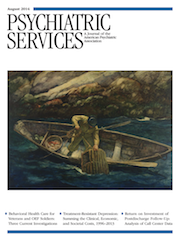Bipolar Disorder in Primary Care: Clinical Characteristics of 740 Primary Care Patients With Bipolar Disorder
Abstract
Objective
This study aimed to describe the characteristics of primary care patients with bipolar disorder enrolled in a statewide mental health integration program (MHIP).
Methods
With the Composite International Diagnostic Interview (Version 3.0) and clinician diagnosis, 740 primary care patients with bipolar disorder were identified in Washington State between January 2008 and December 2011. Clinical rating scales were administered to patients at the time of enrollment and during treatment. Quality-of-care outcomes were obtained from a systematic review of the patient disease registry and compared with a previous study of patients with depressive symptoms in an MHIP. Descriptive analysis techniques were used to describe patients’ clinical characteristics.
Results
Primary care patients with bipolar disorder had high symptom severity on depression and anxiety measures: Patient Health Questionaire–9 (mean±SD score of 18.1±5.9 out of 27) and the seven-item Generalized Anxiety Disorder scale (15.7±4.7 out of 21). Psychosocial problems were common, with approximately 53% reporting concerns about housing, 15% reporting homelessness, and 22% reporting lack of a support person. Only 26% of patients were referred to specialty mental health treatment. Patients with bipolar disorder had a greater amount of contact with clinicians during treatment compared with patients with depressive symptoms from a prior study.
Conclusions
Primary care patients with bipolar disorder enrolled in MHIP had severe depression, symptoms of comorbid psychiatric illnesses, and multiple psychosocial problems. Patients with bipolar disorder received more intensive care compared with patients with depressive symptoms from a prior study. Referral to a community mental health center occurred infrequently even though most patients had persistent symptoms.



